Xinrong Guan
Channel Estimation for Movable-Antenna MIMO Systems Via Tensor Decomposition
Jul 26, 2024
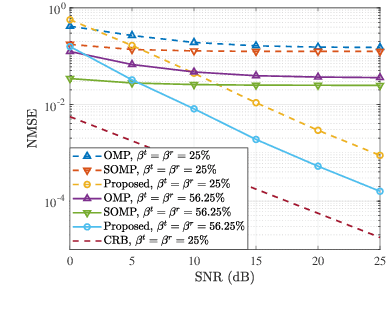
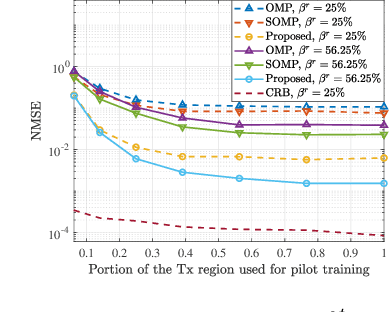
Abstract:In this letter, we investigate the channel estimation problem for MIMO wireless communication systems with movable antennas (MAs) at both the transmitter (Tx) and receiver (Rx). To achieve high channel estimation accuracy with low pilot training overhead, we propose a tensor decomposition-based method for estimating the parameters of multi-path channel components, including their azimuth and elevation angles, as well as complex gain coefficients, thereby reconstructing the wireless channel between any pair of Tx and Rx MA positions in the Tx and Rx regions. First, we introduce a two-stage Tx-Rx successive antenna movement pattern for pilot training, such that the received pilot signals in both stages can be expressed as a third-order tensor. Then, we obtain the factor matrices of the tensor via the canonical polyadic decomposition, and thereby estimate the angle/gain parameters for enabling the channel reconstruction between arbitrary Tx/Rx MA positions. In addition, we analyze the uniqueness condition of the tensor decomposition, which ensures the complete channel reconstruction between the whole Tx and Rx regions based on the channel measurements at only a finite number of Tx/Rx MA positions. Finally, simulation results are presented to evaluate the proposed tensor decomposition-based method as compared to existing methods, in terms of channel estimation accuracy and pilot overhead.
Resource Allocation and Passive Beamforming for IRS-assisted URLLC Systems
Apr 17, 2023Abstract:In this correspondence, we investigate an intelligent reflective surface (IRS) assisted downlink ultra-reliable and low-latency communication (URLLC) system, where an access point (AP) sends short packets to multiple devices with the help of an IRS. Specifically, a performance comparison between the frequency division multiple access (FDMA) and time division multiple access (TDMA) is conducted for the considered system, from the perspective of average age of information (AoI). Aiming to minimize the maximum average AoI among all devices by jointly optimizing the resource allocation and passive beamforming. However, the formulated problem is difficult to solve due to the non-convex objective function and coupled variables. Thus, we propose an alternating optimization based algorithm by dividing the original problem into two sub-problems which can be efficiently solved. Simulation results show that TDMA can achieve lower AoI by exploiting the time-selective passive beamforming of IRS for maximizing the signal to noise ratio (SNR) of each device consecutively. Moreover, it also shows that as the length of information bits becomes sufficiently large as compared to the available bandwidth, the proposed FDMA transmission scheme becomes more favorable instead, due to the more effective utilization of bandwidth.
Energy Efficient Design in IRS-Assisted UAV Data Collection System under Malicious Jamming
Aug 31, 2022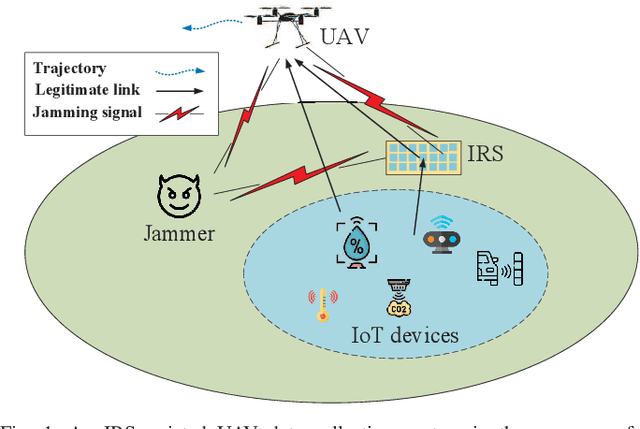
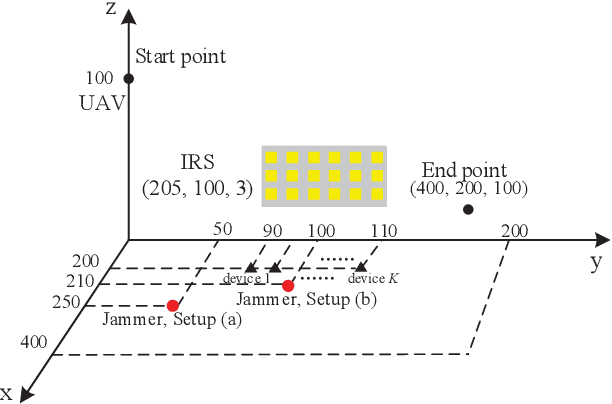
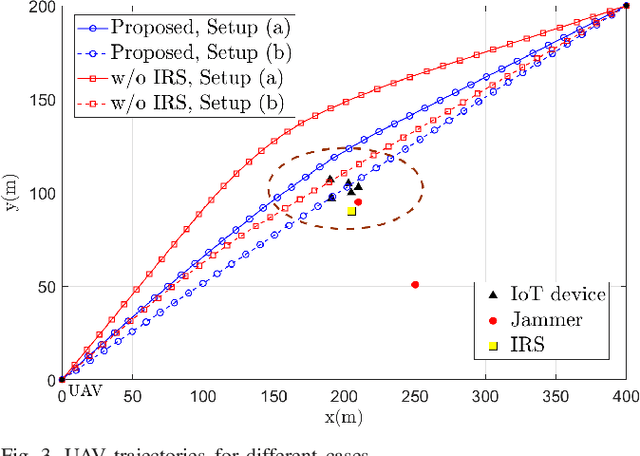

Abstract:In this paper, we study an unmanned aerial vehicle (UAV) enabled data collection system, where an intelligent reflecting surface (IRS) is deployed to assist in the communication from a cluster of Internet-of-Things (IoT) devices to a UAV in the presence of a jammer. We aim to improve the energy efficiency (EE) via the joint design of UAV trajectory, IRS passive beamforming, device power allocation, and communication scheduling. However, the formulated non-linear fractional programming problem is challenging to solve due to its non-convexity and coupled variables. To overcome the difficulty, we propose an alternating optimization based algorithm to solve it sub-optimally by leveraging Dinkelbach's algorithm, successive convex approximation (SCA) technique, and block coordinate descent (BCD) method. Extensive simulation results show that the proposed design can significantly improve the anti-jamming performance. In particular, for the remote jammer case, the proposed design can largely shorten the flight path and thus decrease the energy consumption via the signal enhancement; while for the local jammer case, which is deemed highly challenging in conventional systems without IRS since the retreating away strategy becomes ineffective, our proposed design even achieves a higher performance gain owing to the efficient jamming signal mitigation.
Robust Trajectory and Communication Design in IRS-Assisted UAV Communication under Malicious Jamming
Jan 24, 2022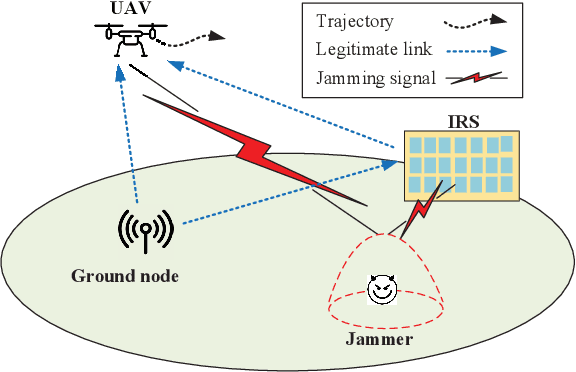

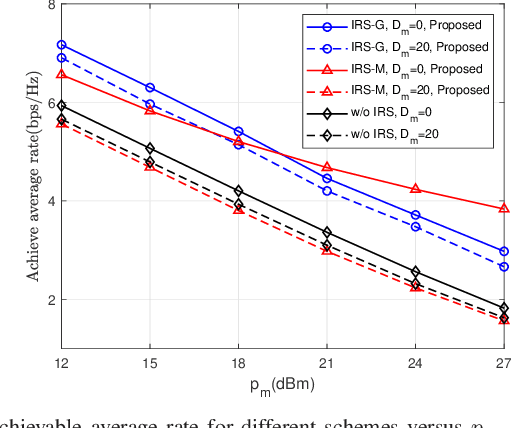
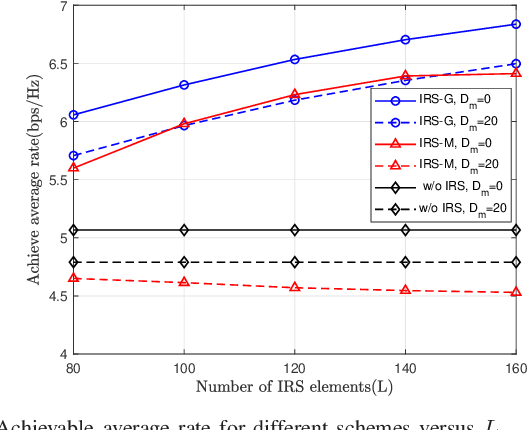
Abstract:In this paper, we study an unmanned aerial vehicle (UAV) communication system, where a ground node (GN) communicate with a UAV assisted by intelligent reflecting surface (IRS) in the presence of a jammer with imperfect location information. We aim to improve the achievable average rate via the joint robust design of UAV trajectory, IRS passive beamforming and GN's power allocation. However, the formulated optimization problem is challenging to solve due to its non-convexity and coupled variables. To overcome the difficulty, we propose an alternating optimization (AO) based algorithm to solve it sub-optimally by leveraging semidefinite relaxation (SDR), successive convex approximation (SCA), and S-procedure methods. Simulation results show that by deploying the IRS near the GN, our proposed algorithm always improves the uplink achievable average rate significantly compared with the benchmark algorithms, while deploying the IRS nearby the jammer is effective only when the jammer's location is perfectly known.
Trajectory and Transmit Power Optimization for IRS-Assisted UAV Communication under Malicious Jamming
Jan 14, 2022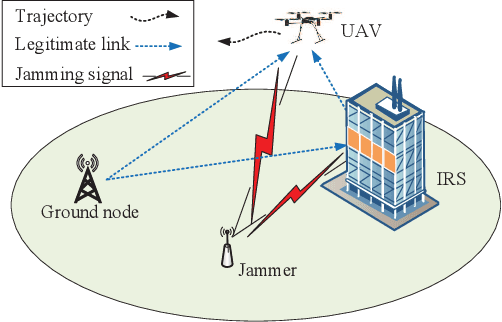

Abstract:In this letter, we investigate an unmanned aerial vehicle (UAV) communication system, where an intelligent reflecting surface (IRS) is deployed to assist in the transmission from a ground node (GN) to the UAV in the presence of a jammer. We aim to maximize the average rate of the UAV communication by jointly optimizing the GN's transmit power, the IRS's passive beamforming and the UAV's trajectory. However, the formulated problem is difficult to solve due to the non-convex objective function and the coupled optimization variables. Thus, to tackle it, we propose an alternating optimization (AO) based algorithm by exploiting the successive convex approximation (SCA) and semidefinite relaxation (SDR) techniques. Simulation results show that the proposed algorithm can significantly improve the average rate compared with the benchmark algorithms. Moreover, it also shows that when the jamming power is large and the number of IRS elements is relatively small, deploying the IRS near the jammer outperforms deploying it near the GN, and vice versa.
Pilot Optimization and Channel Estimation for Two-way Relaying Network Aided by IRS with Finite Discrete Phase Shifters
Oct 28, 2021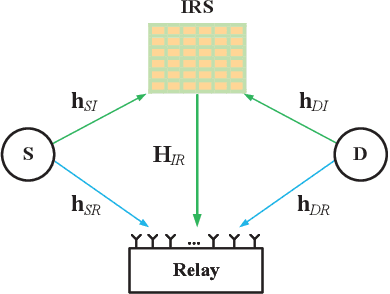
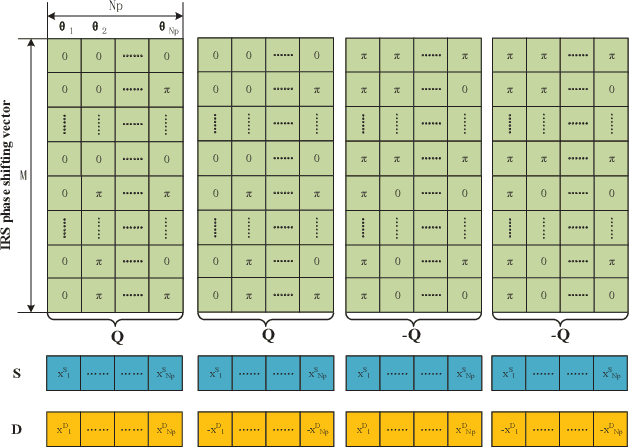
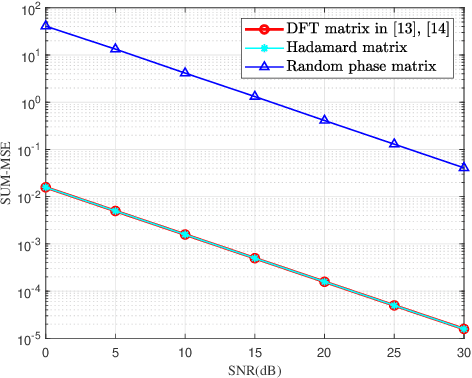
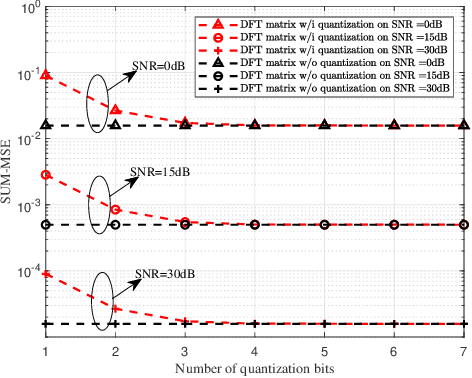
Abstract:In this paper, we investigate the problem of pilot optimization and channel estimation of two-way relaying network (TWRN) aided by an intelligent reflecting surface (IRS) with finite discrete phase shifters. In a TWRN, there exists a challenging problem that the two cascading channels from source-to-IRS-to-Relay and destination-to-IRS-to-relay interfere with each other. Via designing the initial phase shifts of IRS and pilot pattern, the two cascading channels are separated by using simple arithmetic operations like addition and subtraction. Then, the least-squares estimator is adopted to estimate the two cascading channels and two direct channels from source to relay and destination to relay. The corresponding mean square errors (MSE) of channel estimators are derived. By minimizing MSE, the optimal phase shift matrix of IRS is proved. Then, two special matrices Hadamard and discrete Fourier transform (DFT) matrix is shown to be two optimal training matrices for IRS. Furthermore, the IRS with discrete finite phase shifters is taken into account. Using theoretical derivation and numerical simulations, we find that 3-4 bits phase shifters are sufficient for IRS to achieve a negligible MSE performance loss. More importantly, the Hadamard matrix requires only one-bit phase shifters to achieve the optimal MSE performance while the DFT matrix requires at least three or four bits to achieve the same performance. Thus, the Hadamard matrix is a perfect choice for channel estimation using low-resolution phase-shifting IRS.
Anchor-Assisted Channel Estimation for Intelligent Reflecting Surface Aided Multiuser Communication
Feb 23, 2021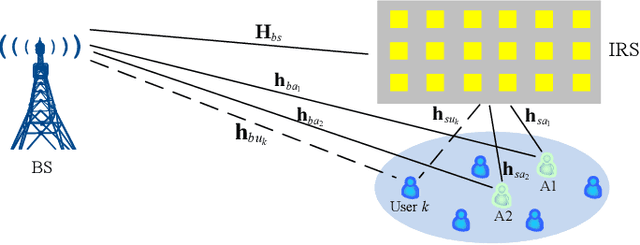
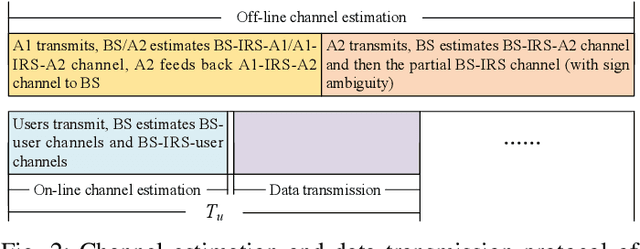
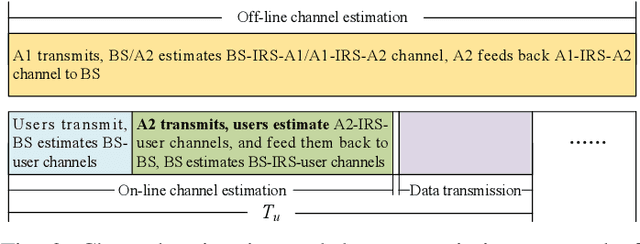
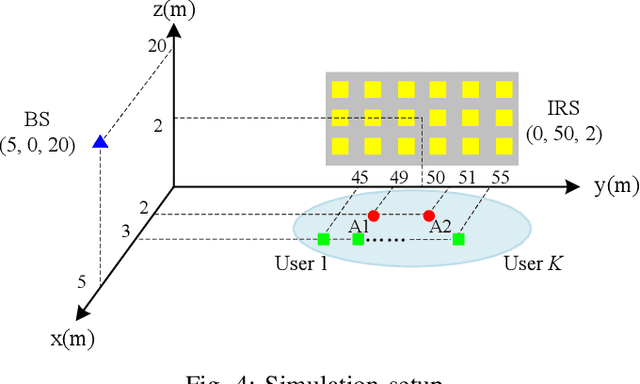
Abstract:Channel estimation is a practical challenge for intelligent reflecting surface (IRS) aided wireless communication. As the number of IRS reflecting elements or IRS-aided users increases, the channel training overhead becomes excessively high, which results in long delay and low throughput in data transmission. To tackle this challenge, we propose in this paper a new anchor-assisted channel estimation approach, where two anchor nodes, namely A1 and A2, are deployed near the IRS for facilitating its aided base station (BS) in acquiring the cascaded BS-IRS-user channels required for data transmission. Specifically, in the first scheme, the partial channel state information (CSI) on the element-wise channel gain square of the common BS-IRS link for all users is first obtained at the BS via the anchor-assisted training and feedback. Then, by leveraging such partial CSI, the cascaded BS-IRS-user channels are efficiently resolved at the BS with additional training by the users. While in the second scheme, the BS-IRS-A1 and A1-IRS-A2 channels are first estimated via the training by A1. Then, with additional training by A2, all users estimate their individual cascaded A2-IRS-user channels simultaneously. Based on the CSI fed back from A2 and all users, the BS resolves the cascaded BS-IRS-user channels efficiently. In both schemes, the quasi-static channels among the fixed BS, IRS, and two anchors are estimated off-line only, which greatly reduces the real-time training overhead. Simulation results demonstrate that our proposed anchor-assisted channel estimation schemes achieve superior performance as compared to existing IRS channel estimation schemes, under various practical setups. In addition, the first proposed scheme outperforms the second one when the number of antennas at the BS is sufficiently large, and vice versa.
 Add to Chrome
Add to Chrome Add to Firefox
Add to Firefox Add to Edge
Add to Edge